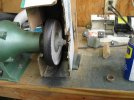It has been mentioned lately about using bench grinders to buff with. I was answering an email from a new maker and gave him this advice. I thought it probably is time to bring this subject up again.
The basic facts of life:
I know people are going to want to buff knives.
I know they will do it even if people tell them it is dangerous.
I know they think they know how to do it.
I know someone will chime in and say, " I buffed all my life and never hurt myself."
What a user may not know:
Buffers can be VERY dangerous.
They can maim you in 1/10 of a second.
Buffer injuries are common. I pretty much feel that anyone who says he never had a buffer incident is not being honest. That is about the same as a blacksmith saying he never burned his fingers.
Here is some advice that I gave in the email:
Buffing a knife is a very different from having used a bench grinder.
Be careful, keep a good grip, and NEVER place the blade anywhere but 3:00 to 5:00 position .... edge down.
Also, don't buff too hard or you can ruin the edge temper.
Also, a bench grinder with a buffing wheel is not the right tool. You need a long arm buffer that has plenty of clearance from the motor. About the only thing tat can be called good is they are usually low power and don't grab as hard as a 1HP unit. The wheel being too close to the motor makes you angle the knife, which will easily lead to snagging or burning the edge.
My buffers are about 28" end to end, and turn 12" buffs. They turn at around 1800RPM. Using a smaller buff will slow down the SFM, but not the RPM. Many of those 6" bench grinders turn at 3450RPM. So with a 6" wheel, they are running the same SFM as mine.
The smaller the wheel, the smaller the safe buffing zone. This means that you have a much smaller place to safely place your blade.
Some Basic Rules:
You must have total concentration.
Turn off the music/headset.
Get everyone else out of the shop. Pets, too.
Tell folks you are buffing and not to disturb you.
Don't buff when you are tired, have been drinking, are mad, or are feeling poorly.
Turn off your phone ringer, but keep the phone close by. It doesn't hurt to pre-dial 911.
I'll leave it to the rest of the chaps here to post their thoughts and experiences.
because with the buffer in front of me with the wheel turning towards me I present the blade edge first in the third quadrant from the outside of the wheel which would be right at 7-7:30 on the clock! ————————my




